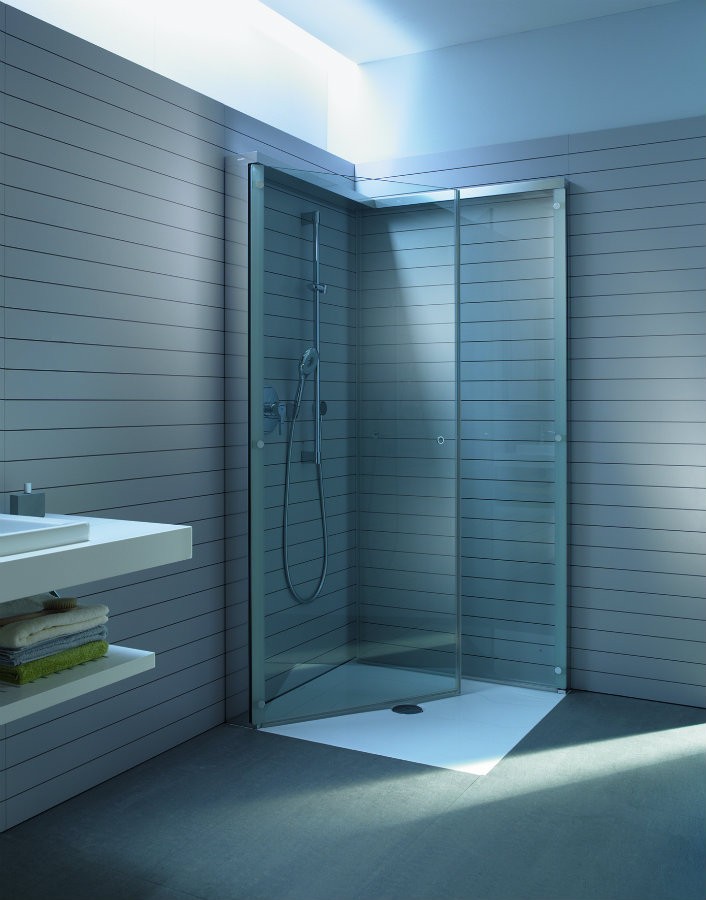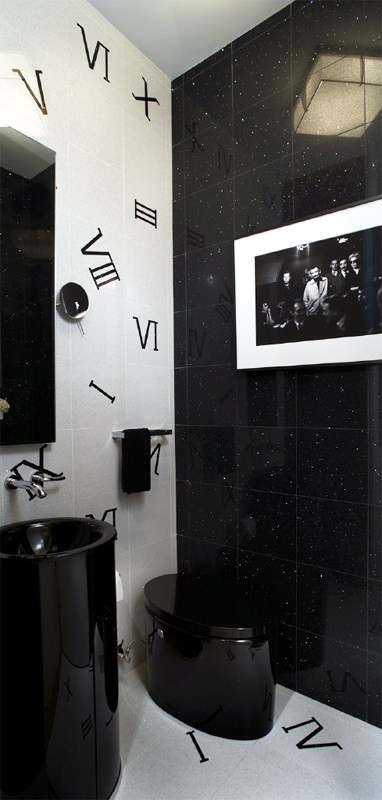The Invisible Bath: Now You See It, Now You Don’t
Written for Art, Antiques and Design (By Gail Green)
Photo: Courtesy of Phillip Ennis
The modern bath has evolved into a space that is hardly recognizable from its predecessor. What one envisions as the typical loo is now reconfigured, redesigned as an extension of the home. That is, bathrooms are now outfitted as though they are yet another living space replete with eye-candy built-ins, decorative accessories, and gorgeous furniture. Here, the usual suspects of shower, tub, and toilet are so well disguised as to magically disappear into forms imagined and creative.
A most obvious change is in the selection of available finishes and materials. Unheard of being used in the bath before, leather now has a water repellent finish so as to adapt to inherent moisture. Used as wall tiles and even countertops, leather has become a popular surface. Wood, in its many guises of luxurious veneers, has also become a suitable material. Adorning sleek built in cabinetry in a wide variety of finishes and colors, its soft hues evoke a warm feeling to an otherwise cool space. Corian, a purist’s delight, is another favored material, especially for tubs and sinks. Its malleability, the subtle blending of one surface into another, from the vertical to the horizontal, offers a marriage of form and function. Here, in seamless manner, the sink integrates and folds over and up, transforming itself into a countertop. On its perpendicular side and without as much as a break or angle to indicate as such, it rises at 45 degrees, forming a backsplash. This material provides a smoothness that is both easy to maintain and beautiful to look at. As for tiles, they have been transfigured into as many colors, finishes, and themes as the imagination can stretch. Coming in a plethora of materials: leather, wood, glass, metal, porcelain, stone, and precious stones, the combinations are endless. Indeed, it is not uncommon to extend tile used in the living or exterior space right into the bath, thus creating a continuity of finish and feel. For instance, mosaics, commonly used for exterior purposes, are thus used to create interior baths in patterns reminiscent of those used by the ancient Romans.
Photo: Courtesy of Phillip Ennis
Faucets, disguised as pipes, gears, wine bottles, fish, oftentimes jewel-encrusted adorn sinks. They seem to rise up from nowhere, like Athena springing from the head of Zeus, spouting water with a torrential thrust. Thus, the usual visible connection of pipe to wall is well disguised behind a floating unit. Shower heads disappear into the ceiling much in the same way the division between shower and bath is hardly distinguishable. The floors and walls flow from space to space and function to function, with hardly a break in tempo.
Photo: Courtesy of Duravit
As for the functional pieces of bathroom furniture one commonly finds in the bath, they are so radically disguised as to completely fool the eye as to purpose. Showers collapse, minimize, and then disappear, like televisions, into walls. Tubs become places of sculptural repose more appropriate for than for children’s bath time. Lavatories, with geometries severe and sculptural, hardly resemble sinks. Storage units are so beautifully designed that you could easily mistake them for dining room cabinetry, putting your best silver in their cupboards. Mirrors of all imagined sizes and shapes are so sublimely configured as surrealistic additions to the wall. Outfitted with tilting side mirrors and/or bulbs. these reflective sculptures set aglow streams of steady beams, as though the wall behind were a field of light against which it floats. It’s all very ethereal.
Photo: Courtesy of Phillip Ellis
Can you sit on a piece of sculpture? Toilets are so craftily molded as to appear as works of art sitting on a wall, at just the right height, of course. Kohler’s hat box which serves as loo and stool, is the ultimate deception, belying toilet for hat box. Utility shelves seemingly suspend in mid-air, floating effortlessly upon the wall. It’s a sort of cleansing poetry, with an iambic pentameter of effects so well well harmonized and balanced.
Adding to the aura of bath as living space is the accompaniment of appropriately styled and sized furniture. Chairs, sofas, stools, tables, and carpets, typically reserved for living areas, now fabricated out of water repellant fabrics are de riguer. Thus, a couch sheathed in terry cloth with faux leather piping is perfectly suitable for the bather just returning from the shower. And, while televisions in baths are not uncommon, those found on the inside door of a cabinet is less so. Visible from the shower, they conveniently disappear into its cabinet when no longer needed. Should the radiant heating of your bathroom floor still leave you cold, install a fireplace. And, finally, as icing on the cake, adorn your bath with a piece of art by adding sculpture or paintings.
Indeed, a respite, a place of serenity and escape, a place to think, write, read and muse, the modern bath epitomizes its image as extension of home.
Click here to view original article
____
Like this post?
Subscribe to our newsletter for more design tips, tricks and insights





